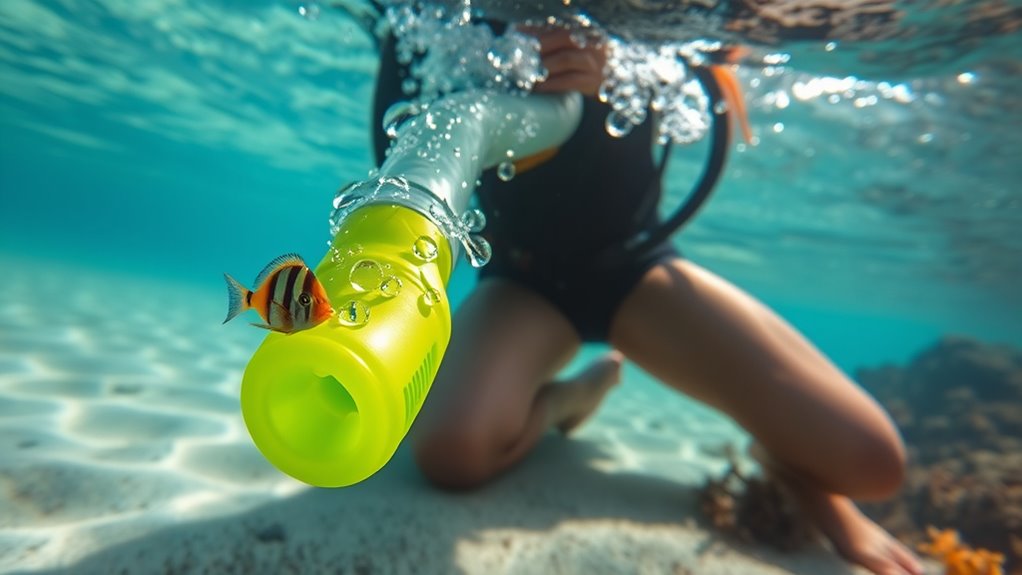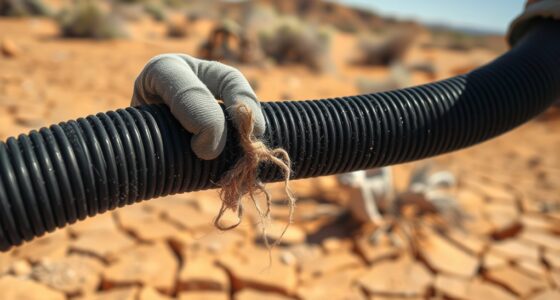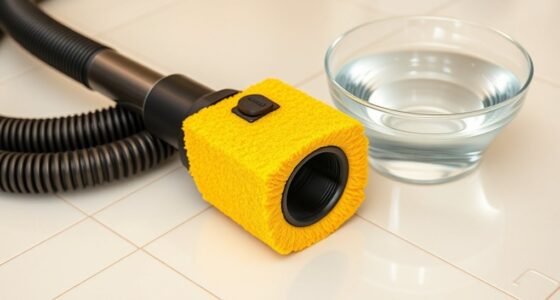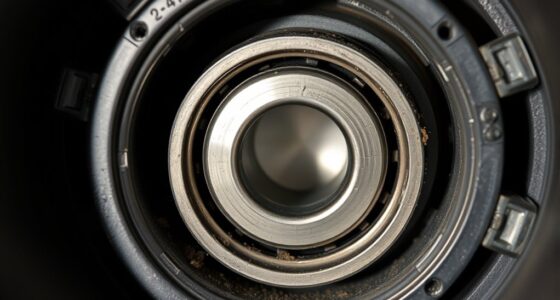To clear blocked snorkel tubes, first inspect the snorkel for debris. Rinse the tube under fresh water to dislodge any particles. Check the mouthpiece for blockages and make certain the internal pathway is unobstructed. If water still enters, adjust your mask straps for a better fit. Regular maintenance is key to preventing issues, and knowing how to troubleshoot effectively can enhance your experience. There’s plenty more to explore about ensuring your gear is in top shape.
Key Takeaways
- Inspect the snorkel tube for visible debris or particles that may obstruct airflow before each use.
- Rinse the snorkel under fresh water to remove any sand or small particles that can block the tube.
- Check the mouthpiece for blockages or damage, ensuring it’s clear for effective airflow.
- Ensure the main snorkel tube is free of obstructions, checking for any bends or kinks.
- Regularly test the purge valve and float mechanism to confirm they function properly and allow for easy clearing of water.

Have you ever found yourself struggling with your snorkel gear just when you’re about to plunge into the water? It’s frustrating, right? You’re ready for an adventure, but then you notice issues that can spoil your experience. One common problem is water leakage, which can send you scrambling for answers. Understanding how to troubleshoot your gear can make all the difference between a great dive and a disappointing one.
First off, check your mask for a proper seal. A foggy mask can be a significant distraction while you’re underwater. If it’s not fitting snugly against your face, water is likely to seep in. Adjust the straps to ensure a tight fit, but not so tight that it’s uncomfortable. If the mask continues to fog up, consider using an anti-fog solution. You wouldn’t want to miss the beauty below because your view is clouded.
Check your mask for a snug fit; a foggy lens can ruin your underwater experience. Use anti-fog solutions for clarity!
Next, pay attention to your snorkel itself. If you’re experiencing water leakage, it could indicate a blockage in the tube. Before you enter the water, inspect your snorkel for any debris or obstructions. Sometimes, sand or small particles can get lodged in the mouthpiece or the main tube. A quick rinse under fresh water can solve this problem. Also, make sure that the purge valve is functioning correctly. If it’s stuck or damaged, it won’t clear water out effectively.
While you’re at it, check the snorkel’s float mechanism. This is the part that prevents water from entering when you dive below the surface. If it’s not working properly, water can rush in, leaving you gasping for air. Ensure it moves freely and isn’t obstructed by any residue.
If you’re still facing problems, don’t hesitate to seek professional help. A reputable dive shop can inspect your gear, providing advice tailored to your setup. They’ll help you identify any wear and tear that could lead to further issues. Additionally, maintaining proper food handling practices for your equipment can ensure longevity and performance.
Frequently Asked Questions
How Often Should I Clean My Snorkel Gear?
You should clean your snorkel gear after every use to maintain it properly. A good maintenance schedule includes rinsing your gear with fresh water to remove salt, sand, and debris. If you’re using it frequently, consider a deeper clean every few weeks, depending on how often you’re in the water. Staying on top of your cleaning frequency helps extend the life of your snorkel gear and keeps it performing at its best.
What Materials Are Snorkel Tubes Usually Made From?
Snorkel tubes are like the lifelines of your underwater adventure, crafted from durable materials such as silicone and rubber. These common snorkel components provide flexibility and comfort while ensuring they withstand the rigors of saltwater. Some models incorporate hard plastic for added strength and longevity. By understanding the snorkel tube materials, you can choose the right gear that enhances your experience, making every dive enjoyable and worry-free.
Can I Use My Snorkel Gear in Cold Water?
Yes, you can use your snorkel gear in cold water, but you need to take some precautions. Wear a wetsuit or drysuit to stay warm and prevent hypothermia. Cold water snorkel tips include limiting your time in the water and staying close to the surface to avoid excessive heat loss. Always check weather conditions and be aware of your body’s signals, so you can enjoy your snorkeling experience safely and comfortably.
How Do I Store My Snorkel Gear Properly?
To store your snorkel gear properly, you need to keep it in a cool, dry place. Did you know that nearly 70% of snorkelers face issues with mold due to improper storage? To avoid mold, rinse your gear with freshwater and let it dry completely before storing it in a ventilated bag. Keep it away from direct sunlight and extreme temperatures, ensuring your equipment stays in top condition for your next adventure.
What Are the Signs of a Damaged Snorkel?
You’ll notice several signs of gear deterioration indicating snorkel tube damage. Look for cracks, tears, or discoloration on the tube, which can compromise its integrity. If the mouthpiece feels loose or has holes, it’s time to replace it. Additionally, if you experience difficulty breathing or notice water leaking during use, these are clear signs your snorkel needs attention. Regularly inspect your gear to make sure a safe and enjoyable snorkeling experience.
Conclusion
In the shimmering sea, don’t let a blocked snorkel tube dampen your diving delight. With a quick flick or a firm blow, you can free that frustrating flow. Remember, practice makes perfect, so don’t shy away from troubleshooting to guarantee your underwater adventures remain wonderfully wild. Embrace the thrill of the tide and the beauty beneath, knowing you’ve got the tools to tackle any trouble that comes your way. Dive deep and enjoy!









